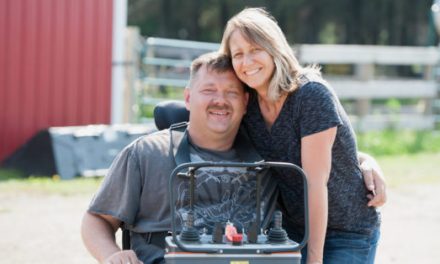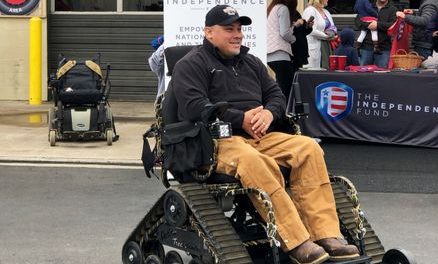I had just turned 55. I was fit and healthy and happily married. My two fantastic kids were both at university, we’d paid off the mortgage on our house and sold our previous house (with money in the bank to spare), and I’d left my job at eBay and set up my own consultancy.
2019 should have been about fun times, weekend breaks, and holidays in the sun with my lovely wife Paula.
Just a regular ride
Just 4 days after my 55th birthday, I’d booked a demo on a new mountain bike called the Yeti SB150. I’d been riding mountain bikes for close to 10 years and rode an average of 75–100 kilometers (km) a week, so I was competent but, if I’m honest, nothing special.
I planned to go out for a steady ride to get a feel for the bike before I rode with my friends the next day. To be safe, I put on my full body armor and a full-face helmet before heading out to session my favourite trail.
On the fifth run, I clipped a tree, and my life changed forever.
I remember lying on the ground, thinking, “What? I’ve never crashed on this trail. I love this trail!”
Then, not realizing what had happened, I tried to get up and couldn’t feel my legs. I will never forget that feeling of absolute horror. I knew instantly what I’d done.
It took 6 hours for the ambulance crew to find me in the woods and get me to the Royal Sussex County Hospital in Brighton, where they established how bad the spinal injury was — an unstable fracture at the seventh thoracic vertebra (T7).
I was then transferred to St George’s Hospital in London for emergency surgery to stabilize my spine.
I spent a week in intensive care, which was grim — especially as I was the only person in there not on a ventilator. After another 2 weeks in recovery, I was transferred to Stanmore, a specialist spinal rehab center, where I spent a further 3.5 months learning to live with my injury.
Rehabilitation
To be honest, I was a bit like a rabbit in the headlights at St George’s. Stanmore is where I really had to face the reality of my injury.
The reality was, as I call them, the three horsemen of the apocalypse: paralyzed from the chest down (meaning that I was unable to walk), no sexual function, and doubly incontinent. Just one of those would be bad, but to have all three is frankly horrendous.
But it is what it is, and you just need to accept what’s happened and get on with it. I also realized early on how incredibly hard it is on your family and friends, so I tried to role model the person I’d like them to see. After all, the better you deal with it, the easier it will be for them. Easy to say, but not always easy to do.
To say that the learning curve at Stanmore was steep would be an understatement. Where do I start?
I had to learn to both live in and operate a wheelchair, learning skills such as going over curbs and back wheel balancing, which is pretty scary; self-catheterizing 24 hours a day (I’ll never get used to the 4 a.m. one); managing my own bowels by digital stimulation (I’m not explaining that one here!); and learning to transfer from my wheelchair to my bed or sofa, etc. (initially, I was hoisted).
I also had intensive physio 5 days a week to help keep my body healthy and build my upper body strength.
What I also learned was to be grateful for the things I had rather than be angry about what I’d lost.
There were 25–30 patients at Stanmore, including quite a few with more severe quadriplegic or tetraplegic injuries and some with difficult personal circumstances. I was in awe of the courage they showed.
I can’t imagine what life must be like without the use of your arms, hands, or both or without being surrounded by a loving family and friends. Divorce is not uncommon after a spinal injury.
Stanmore wasn’t without its challenges. For one thing, I really struggled with the transfers. I initially thought it was a strength issue, but I realized — with the help of my psychologist — that my crash had destroyed my self-confidence when it came to taking any physical risks (you use a small wooden board to shuffle from your wheelchair to your bed, and you can fall off).
I got there in the end, mainly due to the help and support of the amazing National Health Service (NHS) medical team around me, to whom I’m eternally grateful.
But after 3.5 months of intensive physio, poor quality sleep, and low budget hospital food, I was done. I needed to get out — ready or not. Luckily I was… just.
Back to Brighton and hotel living
Unfortunately, the necessary modifications to our house weren’t ready, so I was discharged to the Ibis Hotel near where I live in Brighton.
I don’t mind saying that after slightly more than 4 months of hospitalization, I was both excited and apprehensive about leaving the safety of the hospital. There wouldn’t be any nurses or doctors on hand to help if I fell or got ill. On the plus side, Paula would be joining me at the hotel, which made me very happy.
I cannot describe the bliss of my first breakfast at the Ibis. Having fresh fruit, granola, yogurt, and fresh orange juice followed by croissants and coffee at 11 a.m. (after my carer had been in to help me get up, which takes 90 minutes) was a luxury compared with the porridge and tea served at 6.30 a.m. at Stanmore!
And all the people! It was June, and there was a steady flow of people heading down to the beach. For the first few weeks, I was a little obsessed with watching people walking. I was so jealous.
For me, being in the hotel, being back in Brighton, and seeing my friends again (Stanmore was 100 miles from Brighton) was sooo nice. I also had a lot of support from the local NHS teams, with carers coming in to help me get up and go to bed and physios visiting to continue my rehab, which I greatly appreciated.
I think this phase was a lot harder for Paula. Until then, she could only visit me at Stanmore on Sunday for a few hours. Now, she was sharing a hotel room with me, facing the harsh reality of my injury and all it entailed, including the restrictions it placed on her life and the realization of how our relationship had changed forever.
I’m not going to lie; it was tough at times, and there were a few arguments, but we got through it. Then, after 3 months, the modifications to our house were done, and I could, at last, go home!
Home at last!
I left home in February thinking that I was going out for a quick ride, and I came home 6 months later in a wheelchair. Life really can change in an instant.
On the plus side, we got lucky with our house. A lot of people have to move, but we were able to adapt ours. However, the list was long and the bill large.
We added a ramp to the front door, an automated video entry system, and a through ceiling lift in our living room that took me directly up into our bedroom. My son’s bedroom was converted into an accessible wet room, and he valiantly moved into the spare room, while a second platform lift was installed to get me over the small-but-annoying staircase that led into the kitchen.
These adaptations cost between £50,000 and £60,000, and we were very fortunate that we had the money in the bank. In the United Kingdom, quite a few people who need to wait for local authority funding get discharged into a “microenvironment,” which is a euphemism for putting a hospital bed in their living room and giving them a basin and a bucket. It’s inhumane, and I was determined that that wasn’t going to happen to me.
One thing that made a real difference in enabling my independence was my Batec electric hand bike (see my photo). I was really humbled by my mountain biking friends, who all did a sponsored South Downs Way bike ride to raise money to help me buy one.
I also bought a new lightweight wheelchair at the same time, as although the NHS one is fine, it is a bit heavy and basic. The Batec attaches to your wheelchair and converts it into an electric trike. It has a maximum speed of 30 km per hour (kph) — although I got it up to 36 kph down a hill! — and a range of 50–100 km, which means that I can now go anywhere in and around Brighton & Hove on my own. Most importantly, I can do so without being pushed, which I hated.
All these changes allowed me to finally get home and start to rebuild my life and become more independent. It’s been a slow process, as recovering from the surgery takes a year, but over the months, I have gradually started doing more for myself. I am at the point now where I don’t need much help from Paula. I was determined that she wouldn’t become my carer, as I knew that would be the kiss of death for our relationship.
Looking forward
I had a mentor from the spinal charity Back Up who had a similar crash and injury to me 15 years earlier.
I remember asking him how long it took before he really came to terms with being disabled. He said that his doctors had said 5 years, which was pretty much spot on.
I’m 22 months into that journey, and I’m sure there are going to be challenges ahead, but I feel confident about the future and being able to build a good life for myself and my family. All things considered, I think that’s a good place to be!
Written by Chris Ricketts on December 23, 2020
Published: Medical News Today




